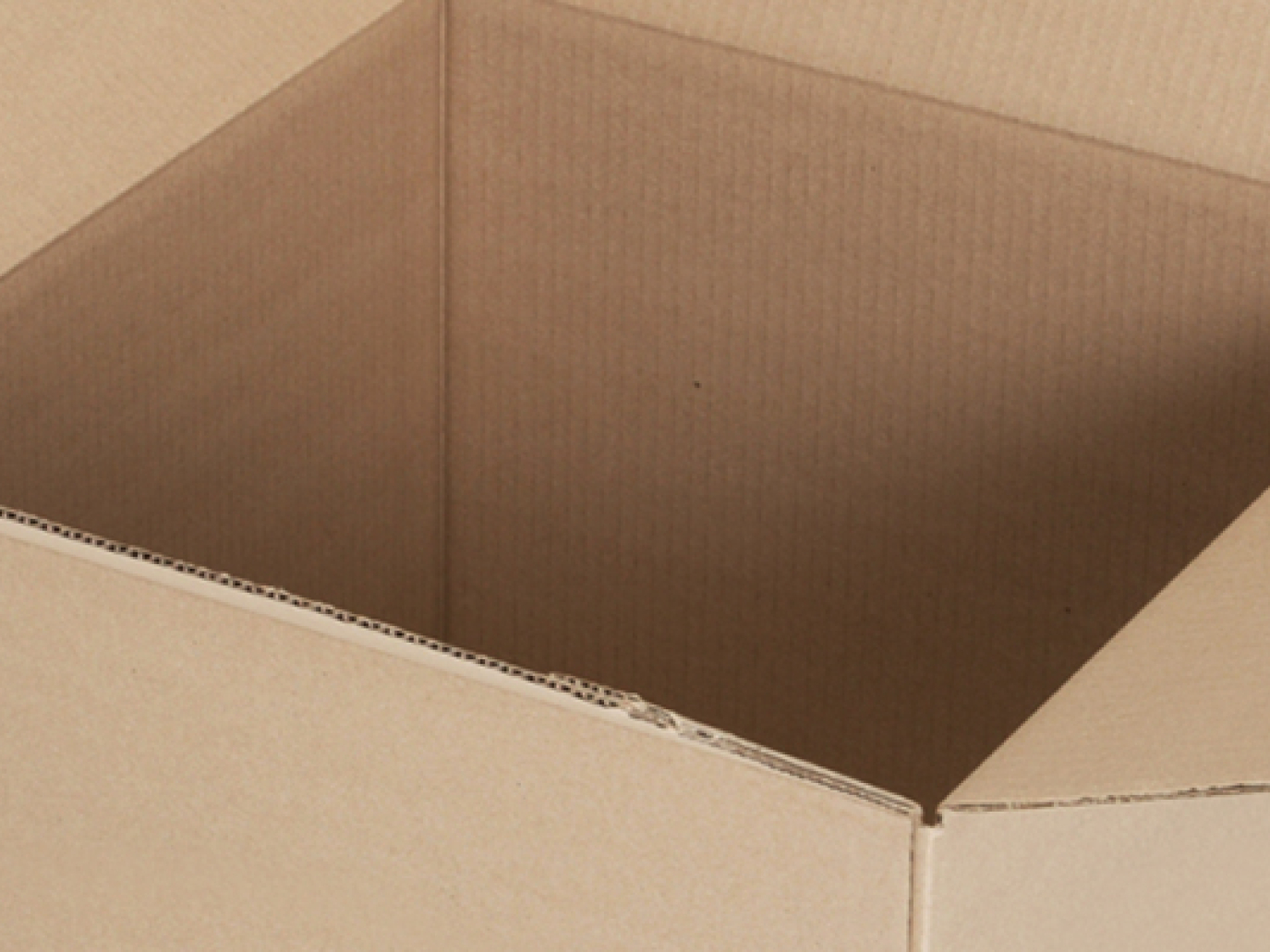Circular economy in our DNA
Recycling is the backbone of the circular economy system and the Italian paper industry is an example of best practice: used paper and cardboard coming from domestic separate waste collection, industry and commerce, are recycled many times in order to produce new goods.
The efficiency of this industry has always been one of Comieco’s main objectives, and its efforts have allowed the management of paper packaging waste to reach the recycling objectives stated by law (80% recycling and 90% recovery) early and successfully.
The greatest contribution to the circularity of the Italian paper industry comes from the packaging sector. In 2017, 5 million tons of pulp were used in production processes on a national scale, more than 92% (4.6 million) of this material is used in the packaging sector.
New recycling objectives required by the Packaging Directive, approved in May of 2018, are the highest among packaging materials: this poses no problems, since the objective for 2025 (75%) has already been reached and overtaken, more effort is required in order to reach the 2030 objective (85%).
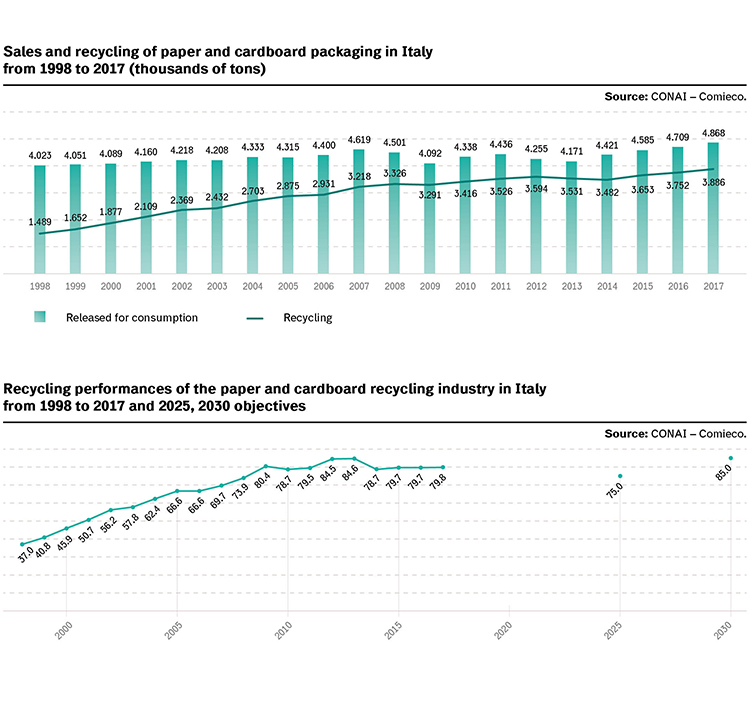
Supporting research and promoting the competitiveness of the sector
Comieco reinforced support activities of consortium companies with new resources.
- In 2015 Comieco started a tender directed at paper mills and consortium platforms for the assignment of a non repayable co-financing for the purchase of technological instruments used in quality control, an essential parameter for the exploitation of recycled paper as a raw material. This investment in technological development was named operation “Fiber Tester”, and represents an unprecedented initiative with a 1 million euro investment from Comieco.
- The Comieco consortium launches the Comieco Factory, a project aimed at accelerating innovation in order to help companies and developers be able to evolve towards third millennium paper packaging. One of the instruments put forth by Comieco in its new project is called “Bando Invenzioni”, that will reward all the subjects who spent resources in order to protect industrial property, patents and registrations for solutions and applications of paper packaging causing a positive environmental impact.
Elements that must be considered: the growth of e-commerce
- The packaging industry is increasingly oriented towards the use of raw material derived from renewable or compostable fibers as a strategic element for a synergic management of cellulosic and organic waste. The development of packaging material from degradable fibres according to the UNI-EN 13432 Technical European norm is an opportunity for the competitiveness of circular bioeconomy, where everything is recovered and processing costs and environmental impacts are reduced.
- E-commerce: The value of Italian B2C e-commerce was estimated at 24 million euros by the B2C E-Commerce Observatory, Netcomm – School of Management of the Politecnico di Milano, the equivalent of 6% of all Italian purchases. If we consider products sold exclusively through ecommerce, i.e. the part of e-commerce that requires logistic and packaging, the total value is 12 billion euros, showing a 28% growth in 2017, equal to 52% of Italian e-commerce. The volume of daily deliveries in Italy is estimated around 15 million euros.
- The growth of e-commerce volumes and the development of multi-channel models are redesigning logistic flows across our cities. New flows are causing an increase in small and medium size delivery vehicles used to deliver products bought through e-commerce at home or at places of withdrawal. Volumes are now very high, and these new flows cause evident traffic and mobility issues.
- This issue is particularly evident in large cities, where 1 out of 2 inhabitants (4.6 in small centres with less than 10,000 inhabitants) buys online, and where mobility is more complicated compared to small centres. Estimates show around 15 million e-commerce deliveries per month in Italy. By subdividing deliveries amongst inhabitants and considering the density of e-shoppers, we estimated that 23,000 deliveries enter the Milan municipality every day (source: “Logistics and packaging for e-commerce”, white book drawn up by Netcomm and created with the contribution of Comieco).
- The development of e-commerce is redefining consumer habits, city logistics, storage spaces, the production chain, norms, communication, transport and delivery services and packaging technologies. An increase that is connected to the Italian paper sector: three new large paper mills are about to open and they will produce and mobilize thousands of tons of cardboard every year; estimates show that approximately half of this material will be used for online B2C or B2B sales.
Goals for the future
Focusing on southern Italy. Separate waste collection reaches a pro-capita value of more than 60 kilograms in northern and central Italy, but in the south this value is halved. Therefore, we must draw up new strategies and ideas to spur the growth of separate waste collection in southern Italy, following in the footsteps of the “Piano per il Sud” (plan for the South), sponsored by the Ministry of the environment and the protection of territory and sea, and the ANCI tender that guaranteed Comieco’s support for affiliated municipalities with waste collection deficits, in order to finance the purchase of equipment and vehicles.
Contribute to collective wellbeing. Separate waste collection is one of the most important indicators of Italian civic duty, as shown by 86% of interviewees (Annual Ipsos Observatory, 2018). Separate waste collection is one of the simplest and quickest practices that contribute to collective well being, not just as a means to dispose of waste.
Prevention. Producing packaging limiting the impact on the environment as much as possible is the best option when managing packaging waste. Comieco operates in the field of prevention on every level of the industry, providing stakeholders – technicians, businesses, designers and university students – with guidelines for the design and production of eco-friendly packaging.
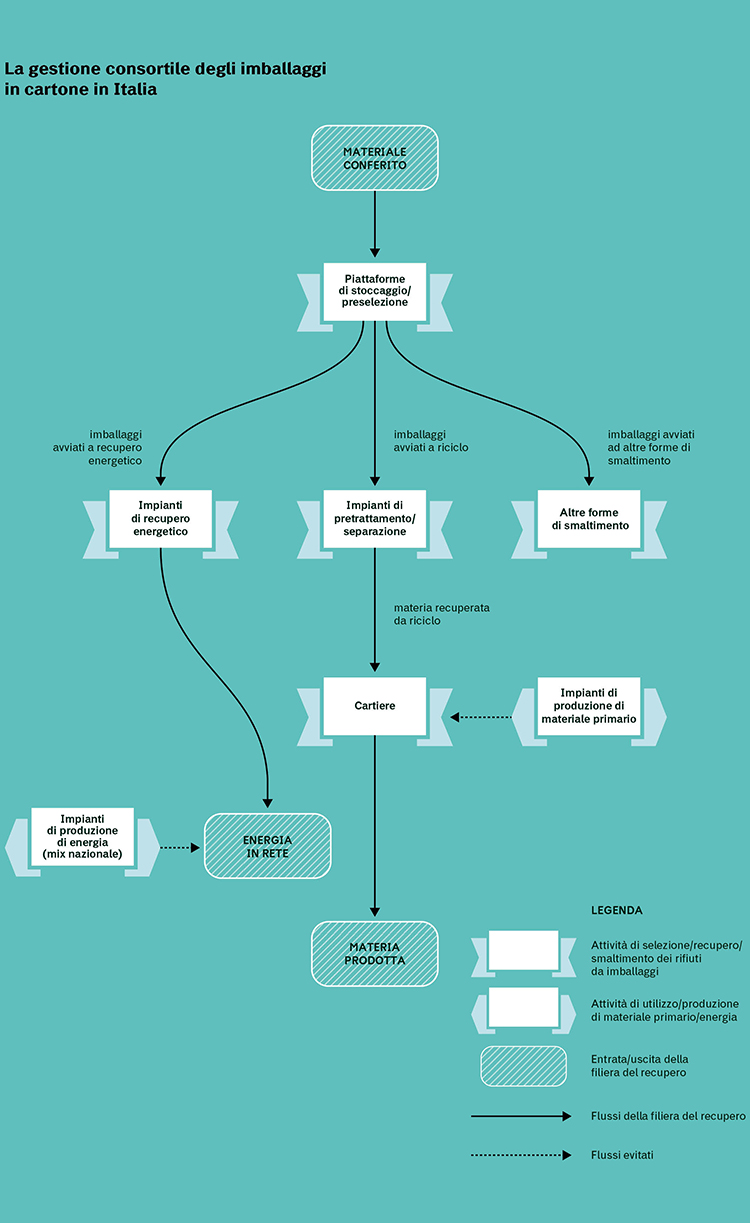
The environmental and socio-economic benefits of consortium management
In 2017, more than one million tons of paper and cardboard packaging waste were recycled thanks to the activities of the Comieco consortium, more than one fourth of the total paper packaging recycled on a national level.
The quantities recycled by the Consortium between 2005 and 2007 show a constantly increasing trend, with the exception of the three year period between 2011 and 2013, where figures reached -28% compared to 2010; numbers started growing again and reached an all time high last year.
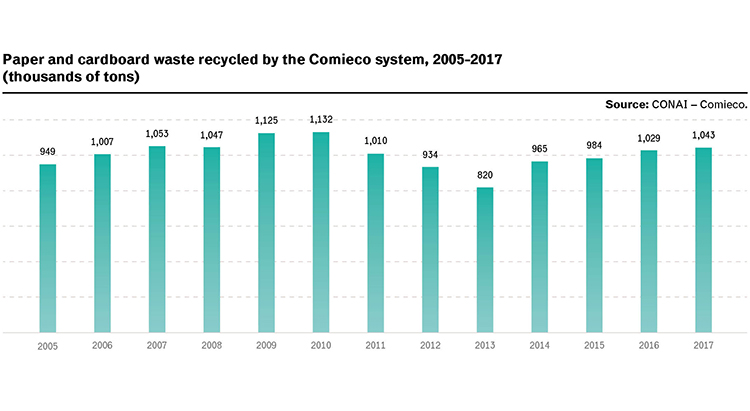
According to the CONAI LLC Tool results, recycling activities involving paper and cardboard packaging waste coming from separate and mixed waste collection from public areas carried out by Comieco between 2005 and 2017 avoided the consumption of approximately 11 million tons of raw materials, the equivalent of more than 4 million reams of A4 paper.
The numbers regarding raw material saved through recycling reflects the trends of recycled material. Thanks to the recycling of paper and cardboard packaging, the activities carried out by the consortium in 2017 prevented the use of more than 869,000 tons of raw material, marking a 30% increase compared to 2013, thanks to the increase of recycled packaging waste.
In addition to avoiding the use of raw material, the recycling activity carried out by Comieco allows other important savings, starting from energy. Packaging waste recycled between 2005 and 2017 avoided the use of approximately 49 TWh of primary energy, the equivalent of the primary energy consumption generated by 29 medium-sized thermoelectric power plants. Energy savings show an irregular trend over the years, characterised by a drop in the three year period between 2011 and 2013, caused by the reduction of recycled material.
In fact, the development of primary energy mirrors the trends of recycled quantities. Furthermore, a quota of the conferred material is used for energy recovery in 2013 (10% of the total for that year), a choice made by the consortium for accounting reasons. The energy expended for unit production of raw material from fossil fuels is mostly steady in the course of the years, and the small variations in unit energy use depend on the variations of energy use in paper and cardboard production processes.
The energy saved by recycling paper and cardboard packaging managed by Comieco in 2017 was equal to 3.7 TWh of equivalent primary energy, marking a 3% increase compared to 2016 and a 12% increase compared to 2013.
In addition to saving energy, recycling also produces vital direct benefits in terms of greenhouse gas emissions. Specifically,the activities carried out by the Consortium between 2005 and 2017 prevented the emission of almost 12 million tons of CO2eq, the equivalent of the emissions generated by 3.6 million vehicles with an average travelled distance of 20,000 kilometres in a one year period. The total amount of CO2 saved between 2005 and 2017 is positive (+22%), even though the trend is quite irregular.
The recycling of paper and cardboard packaging carried out by the Consortium has prevented the emission of 986,000 tons of CO2eq in 2017, 2% more than 2016.
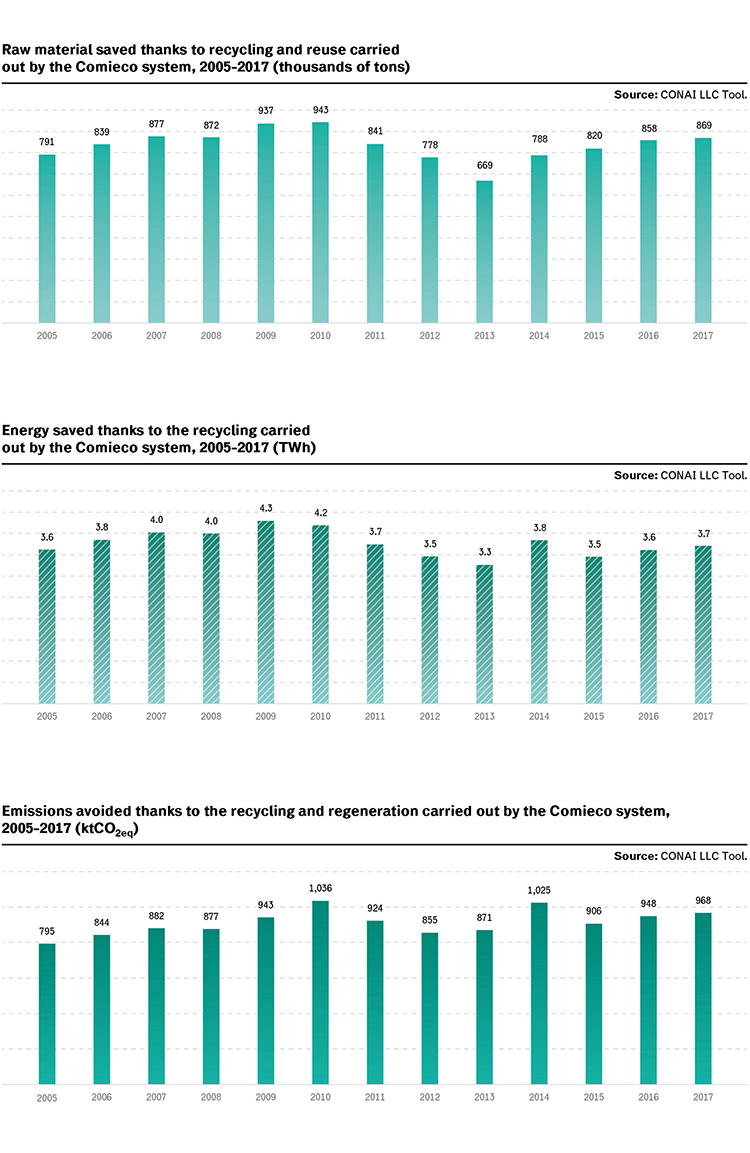
Starting from the environmental environments we just illustrated, it is possible to estimate the relative direct and indirect economic benefits for the country-system through the LLC Tool. The total economic benefit in 2017 was 113 million euros, more than double the amount registered in 2005. On the whole, the Consortium industry for the recovery of paper and cardboard packaging waste has generated an economic value of 1 billion euros. It is made up of:
- 795 million euros of direct benefits generated by the consortium recycling of paper and cardboard packaging waste, represented by the economic value of saved raw material; these benefits amounted to 84 million euros in 2017 (a threefold increase compared to 2005);
- 335 million euros of indirect benefits connected to the CO2eq emissions avoided thanks to the recycling activity carried out by consortium management; the figure for 2017 is 29 million euros (+21% compared to the estimated data for 2005).
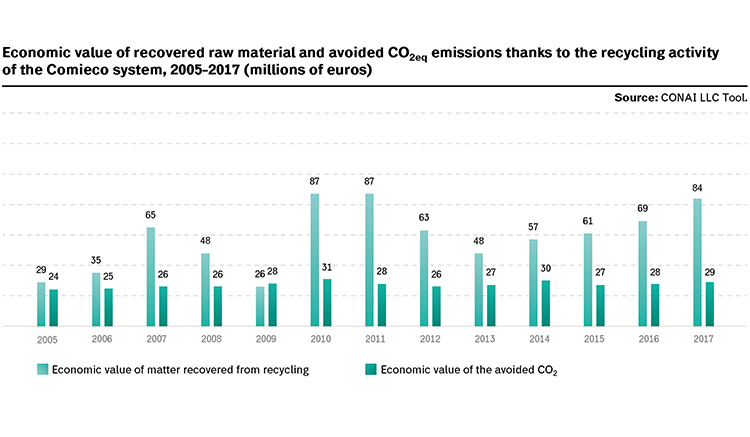
Top image – Meathead Movers@flickr_CC BY-SA 2.0/writings removal


